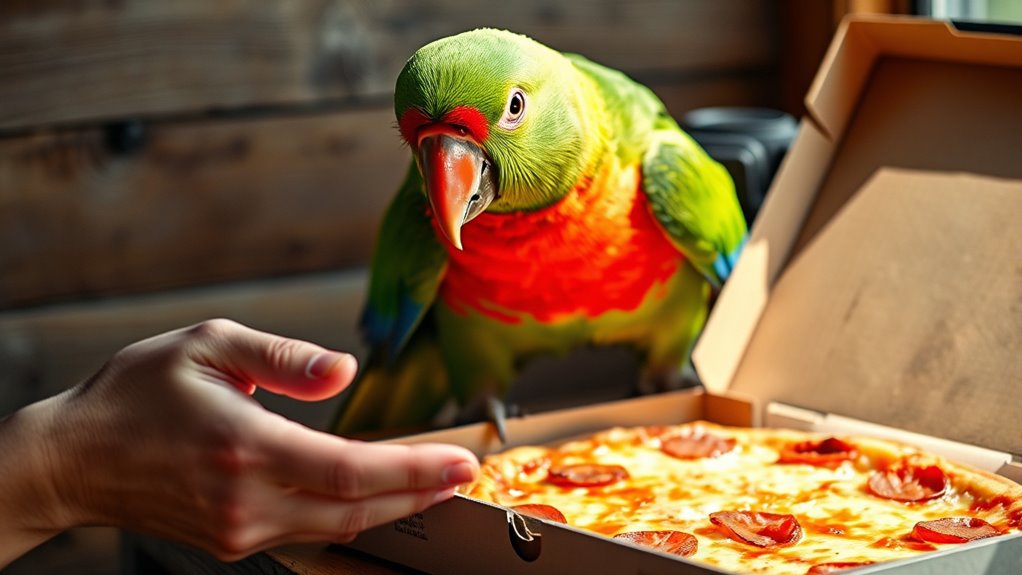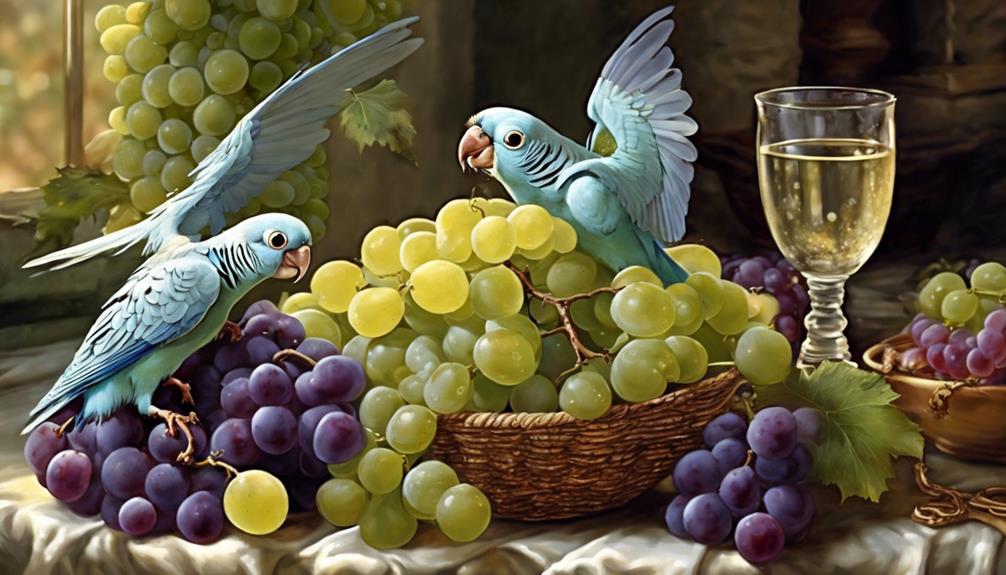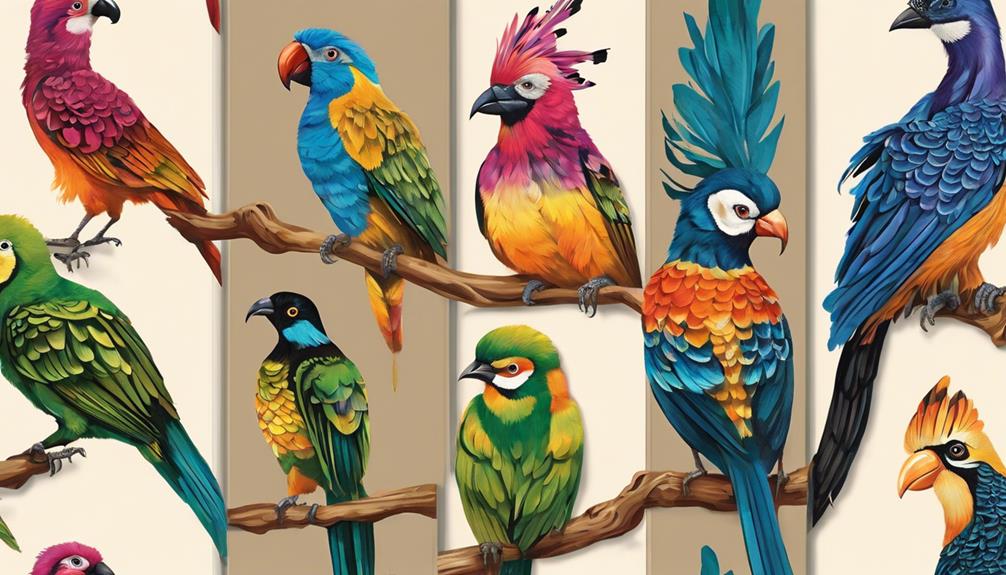You’ll love this story of Kiwi, the parrot who learned to order pizza through playful, positive reinforcement training. By consistently practicing vocabulary, linking sounds to actions, and rewarding success, the owner guided Kiwi to mimic calling the pizza place and even saying “Pizza, please!” It’s a fun example of how pets can develop communication skills with patience and creativity. Keep exploring to discover more about Kiwi’s amusing and impressive progress.
Key Takeaways
- Kiwi, a parrot, learned to mimic and place pizza orders through consistent training and positive reinforcement.
- The owner used vocabulary expansion and contextual cues to help Kiwi understand the ordering process.
- Audio recordings reveal Kiwi enthusiastically mimicking the entire pizza order, including calling and confirming.
- The training involved linking sounds to actions, encouraging playful interaction and meaningful communication.
- This story showcases how pets can develop impressive functional skills with patience, creativity, and proper reinforcement.

When a clever parrot named Kiwi somehow learned to order pizza, it caught the attention of both pet owners and tech enthusiasts alike. You might wonder how a bird, known for mimicking sounds and words, could become so skilled that it actually places an order. The secret lies in the way you approach vocabulary development and pet training techniques. By carefully shaping Kiwi’s behavior and reinforcing specific phrases, you’ve managed to turn a simple parrot into a surprisingly savvy communicator.
The key to Kiwi’s success was consistent training sessions focused on building vocabulary. You started by teaching basic words and phrases related to food and ordering. Repetition played a *vital* role—saying “pizza,” “order,” and “please” often enough so Kiwi could associate these words with the act of requesting a delivery. Over time, you used positive reinforcement, rewarding Kiwi with treats or praise whenever it repeated the right words. This method of pet training techniques doesn’t just encourage learning; it helps the bird understand context and purpose behind the words. Your patience and persistence made a difference, transforming Kiwi from a talkative parrot into a capable communicator.
Consistent training and positive reinforcement transformed Kiwi into a skilled, communicative parrot.
As Kiwi’s vocabulary expanded, you noticed it began to string words together in meaningful ways. One day, it surprised you by loudly calling out “Pizza, please!” during a casual afternoon. That moment sparked the idea to teach Kiwi how to actually place an order, which you did by linking specific sounds to actions. You created a system where Kiwi could “say” the words to your voice commands, and you’d pretend to take the order. Over weeks, Kiwi learned to mimic the sound of a phone ringing, followed by “Hello, I want pizza!” This playful approach made training enjoyable for both of you and reinforced pet training techniques centered on engagement and positive feedback.
The result? Kiwi now mimics the entire process, from calling the pizza place to confirming the order. When you share the hilarious audio of Kiwi’s attempt to order pizza—complete with its enthusiastic, if slightly garbled, voice—it becomes clear how effective your training methods were. This isn’t just about a bird talking; it’s about how you used careful vocabulary development and pet training techniques to nurture Kiwi’s ability to communicate in a fun, functional way. Interestingly, this process also highlights the importance of protective styling benefits for long-term pet grooming and maintenance, ensuring Kiwi remains comfortable during training sessions. Seeing your parrot confidently “place” an order reminds you that with patience, consistency, and a little creativity, pets can learn remarkable skills, making the bond between you even more special.
Frequently Asked Questions
How Did the Owner Teach the Parrot to Order Pizza?
You can teach a parrot to order pizza using simple training techniques and behavioral training. Start by rewarding your bird when it mimics the words or phrases you want, like “pizza.” Repetition and positive reinforcement are key. Consistently practice, and soon your parrot will associate specific cues with ordering, making it easier to communicate your desired behavior. Patience and consistency make all the difference in effective training.
What Specific Phrases Did the Parrot Learn to Say?
You might wonder what specific phrases the parrot learned. It picks up bird vocabulary and parrots’ imitation skills to mimic common order phrases. The parrot typically says, “I’d like a pizza,” “Large pepperoni,” or “No olives, please.” These phrases showcase its ability to imitate human speech, making the interaction hilarious. Its training highlights how parrots can learn to use words in a fun, conversational way.
Has the Parrot Ordered Pizza From Different Restaurants?
Imagine your parrot orders pizza from various restaurants, showing its restaurant preferences. You might find it requests different parrot’s favorite toppings, like olives or peppers, depending on the place. While most parrots stick to one favorite, some surprisingly mix it up, asking for pizza from different restaurants. So, your feathered friend could easily learn to order from multiple spots, showcasing its ability to adapt to various restaurant preferences.
How Does the Owner Respond to the Parrot’s Calls?
When your parrot makes calls, you respond with patience and encouragement, recognizing that its communication is a learning process. You listen carefully to its sounds, understanding that it’s trying to interact and maybe even mimic ordering pizza. Your calm, supportive attitude helps your feathered friend feel safe, fostering better communication. This patience builds trust and makes the experience enjoyable for both of you, turning everyday moments into fun learning opportunities.
Are There Any Other Animals That Can Learn to Order Food?
Imagine revealing a secret language within animals, revealing their ability to communicate like humans. While parrots are masters of mimicry, other animals like dogs and dolphins are also being trained through innovative techniques to understand and even order food. These training techniques harness their natural instincts and intelligence, transforming them into conversational partners. As science advances, more animals may soon surprise us with their newfound ability to express preferences and needs.
Conclusion
You can’t help but smile as you imagine this clever parrot transforming into a tiny, feathered waiter, placing orders with surprising confidence. Its newfound talent turns a simple act into a delightful dance of mimicry and mischief, like a comedy show with a feathered star. This quirky story reminds you that even the smallest creatures can surprise you, proving that laughter and wonder are just a clever squawk away. Sometimes, life’s funniest moments come from the most unexpected parrots.









